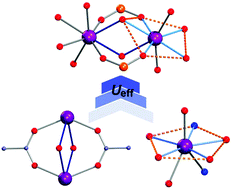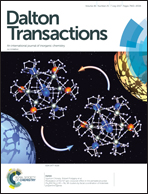Geometry and magnetic interaction modulations in dinuclear Dy2 single-molecule magnets†
Abstract
Geometry and magnetic interaction modulations in a series of dinuclear dysprosium compounds, [Dy2Lz2(OAc)6]·2CH3OH (1), [Dy2Lz2(C6H5CO2)6]·2CH3CN (2), and [Dy2L2(SO3CF3)4THF4] (3) (Lz = 6-pyridin-2-yl-[1,3,5]triazine-2,4-diamine; L = N-(2,3-dimethylbut-3-en-2-yl)-N-hydroxynitrous amide; THF = tetrahydrofuran), can effectively tune the relaxation dynamics of magnetization. The dysprosium centres of compounds 2 and 3 display a hula hoop-like geometry; however, those in 1 show the monocapped square antiprismatic geometries. Moreover, the Dy2 cores of compounds 1 and 3 were linked by μ2–η1:η1 and μ2–η1:η2 bridging modes, thus generating shorter intramolecular Dy⋯Dy distances as compared to those in compound 2. Consequently, these three compounds demonstrate distinct magnetic properties. Compounds 1 and 2 behave as single-molecule magnets (SMMs) under an appropriate static dc field; in addition, 2 displays field-induced multiple relaxation processes under a 1000 Oe dc field. Compound 3 shows a high relaxation energy barrier of 102 K in the zero dc field. These three interesting compounds with Dy2 cores shed light on the coordination geometry and magnetic interactions for the modulation of the properties of SMMs.



 Please wait while we load your content...
Please wait while we load your content...